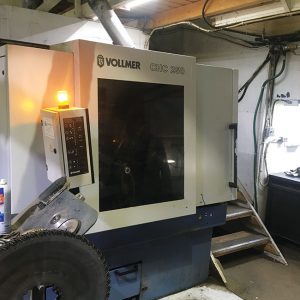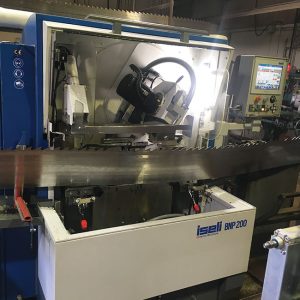
Features
Equipment
Mills
Sawmilling
Cutting-edge filing: inside Apollo Forest Products’ filing room
October 18, 2021 By Ellen Cools
 Shawn Marin, one of the benchmen at Apollo Forest Products, next to the Vollmer CHC 250 top and face dresser. Photos courtesy Kevin Ransom.
Shawn Marin, one of the benchmen at Apollo Forest Products, next to the Vollmer CHC 250 top and face dresser. Photos courtesy Kevin Ransom. In the remote community of Fort St. James, B.C., Sinclar Group’s Apollo Forest Products has been producing lumber for over 50 years.
Apollo Forest Products, which started out producing railroad ties, now produces six- to nine-foot products using primarily white spruce and pine, along with some balsam fir. On a yearly basis, the mid-sized mill produces around 140 mmbf, manufacturing two-inch and one-inch material for the commodity market, along with specialty products for the construction industry.
The mill employs 130 people full-time, six of whom work in the filing shop, fixing up the mill’s bandsaws and round saws, explains Kevin Ransom, lead filer at Apollo.
Ransom is the head of the saw filing department, in charge of organizing his employees’ shifts, ordering saws, and maintaining the machines in the shop and in the sawmill. Ransom and his five co-workers handle all the filing duties, including several different size bandsaws and round saws.
The first of those is in the QM Industries slasher, which cuts logs into eight- or nine-foot blocks. The logs are then sorted by diameter into two sorts – small or large. The small blocks go through small log canter, with a four-inch cant saw running about 550 feet per minute. The cants then go to a Comact TBL2, a gang saw that cuts them into 2x4s or 2x6s. The TBL2 takes 20-inch saws, with 100-inch plates and 60 teeth on each of them, Ransom says.
Blocks that are too large – 24 inches or more – go through a bandsaw, which cuts them down into six-inch or four-inch cants. Then the cants are transferred to the TBL2 for further processing into products ranging in size from 1×3 to 2×6. The bandsaws are 36 inches long with 231 teeth, Ransom says.
Meanwhile, sideboards are transferred to a re-saw edger, which has a 20-inch saw with a 120-inch plate and 60 teeth.
“It’s a shifting edger, so that’s why we’re using a thicker plate,” Ransom explains. “But, it’s only cutting, at most, a two-inch slab.”
The mill also has a sideboard edger from Optimil that cuts up to two-inch slabs, running a 24-inch saw with a 140-inch saw plate and 50 teeth, he says.
Because the mill largely runs spruce and pine, and only occasionally balsam fir, everything is run at the same speeds with the same saws. This means Ransom and his crew don’t have to adjust the amount of tension in the saws depending on the species running through the mill. However, the saws are changed approximately every four hours.
To handle the mechanical duties of the filing room, Ransom and his crew run a few different machines.
The newest one is an Iseli BNP200 4 axis CNC bandsaw grinder, which can do profile grinding of standard and Stellite-tipped bandsaw blades and top and face grinding of Stellite and Carbide-tipped blades.
The machine features automatic insertion of the blade, meaning the machine inserts the saw until it reaches a predetermined height and then closes the sheet clamp. The machine can determine the first saw tooth and calculate the tooth pitch, and then the grinding process begins. Essentially, an operator only needs to insert the blade and then press a button to start the machine.
“It’s amazing,” Ransom says. “It’s got a corundum grinding wheel on it that doesn’t seem to ever wear out. We run oil on that. It’s pretty much eliminated the cracks.”
Ransom also uses an old TMH 10-tooth Vollmer swage, but “that’s pretty much obsolete right now,” he says. “They’re not going to make parts for it anymore, so we’re in the market for a new swage, which will probably also be Iseli.”
But, for the round saws, they are happy with their current fleet of Vollmer equipment, including a CHC 250 face and top dresser, a CHF 210 side dresser and a CPF 200 side dresser. They also have an ECO face and top dresser.
The round saws are carbide-tipped, so Ransom and his team use diamond wheels to grind them. A benchman takes care of the saw plates, leveling them and adjusting the tension.
Accordingly, Apollo Forest Products invests in their people, training new filers in-house. Given the ongoing shortage of available saw filers, this strategy is easier than trying to hire outside talent. New saw filers typically come from a mechanical or utility background, and begin working on the graveyard shift changing knives, Ransom explains.
“I have a really good crew right now,” he adds.
Moving forward, Ransom says he would like to see the filing room get a new exhaust system – a project that is currently in the works.
And, fortunately, management at Apollo Forest Products is on board to help bring in any necessary equipment to help boost efficiencies in the filing room.
“If I submit a machine to put on our budget, I always have a good reason, so they’ll usually get it for me,” Ransom explains. “Our filing room is fairly up-to-date – everything’s new.”
We are looking for other filing rooms that would like to be profiled in this space. If you are interested, please ask your mill management for permission. The mill will always get final approval on the article before printing. Please contact CFI editor Ellen Cools at ecools@annexbusinessmedia.com if you are interested.
Print this page

